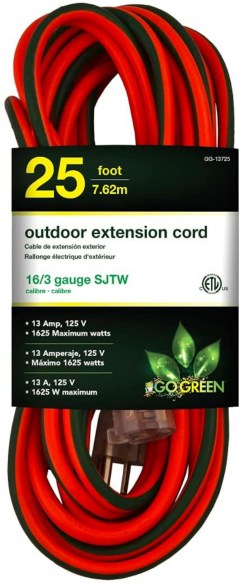BestReviews is reader-supported and may earn an affiliate commission. Details

This 14-gauge choice is best for medium-duty tasks.
This 14-gauge choice is best for medium-duty tasks.
The dark color of this 50-foot product allows it to be less obtrusive in most environments. It has a 3-prong (grounded) connection and is suitable for a maximum of 15 amps.
This is a rare customer-satisfying product that doesn't have any obvious consistent flaws.

A lighter-duty model (16 gauge) that is intended to be safe for outdoor use.
A lighter-duty model (16 gauge) that is intended to be safe for outdoor use.
This is manufactured to resist both sunlight and moisture so it is suitable for outdoor use. It is also designed to be abrasion resistant, is ETL listed, and has a lighted end for safety.
Rarely, a cord with a non-functioning light manages to slip through quality control.

A heavy-duty 12-gauge, 3-prong design that's designed for the toughest jobs.
A heavy-duty 12-gauge, 3-prong design that's designed for the toughest jobs.
This UL-listed lighted model is a high-visibility yellow. It is abrasion-resistant and maintains flexibility in both hot and cold weather. The oversized plug provides an easy grip.
Because this is a heavier 12/3-gauge product, it can be harder to maneuver than others.

A pack of 2 white, 12-foot indoor extension cords that are perfect for light-duty use.
A pack of 2 white, 12-foot indoor extension cords that are perfect for light-duty use.
Each of these features 3 3-prong female connections. They are affordably priced, designed for durability (10-year warranty), and have a built-in hook for easy hanging.
Some do not like that these plugs are designed so that only 1 can be used on a standard home outlet.

A 100-foot cold-resistant, 3-prong electric cord for outdoor events and powering up equipment on your property.
A 100-foot cold-resistant, 3-prong electric cord for outdoor events and powering up equipment on your property.
The lighted end serves as an indicator of whether it is powered on. The grounded 3-prong outlet was designed with safety in mind among the outdoor elements.
Some wish the light indicators were brighter than they are.

We recommend these products based on an intensive research process that's designed to cut through the noise and find the top products in this space. Guided by experts, we spend hours looking into the factors that matter, to bring you these selections.

Most people have an extension cord in use in their home or business. Because these devices are so easy to use, you might be tempted to just grab one off the shelf, plug it in, and never give it a second thought.
However, there are quite a few things to know about different extension cords. Having this knowledge will help you choose a cord that not only meets your needs but is also safe to use.

Simply put, an extension cord is an electrical cord. When connected to the cord of an electrical device, the extension cord allows you to position the device farther from an electrical outlet than the device’s own cord would allow.
You can find extension cords ranging in length from 6 to 100 feet or more. They also are available in different gauges to carry different levels of electrical power safely. But no matter how long or powerful extension cords may be, the basic interior components are all the same.
The jacket is the cover that you see on the exterior of the cord. If the jacketing on an extension cord is too thin, the cord could overheat, melt, and cause a fire.
Round: The jacket is round and thick on heavy-duty extension cords. Thick wires generate a lot of heat, and the thick jacket protects you and objects around the cord from this heat.
One end of the extension cord has a two- or three-pronged plug.
The other end of the extension cord has a receptacle (the number of holes matches the number of prongs on the plug end).
Most extension cord manufacturers use a series of letters to designate the features of each cord. These letters appear in the name of the cord or in the specifications. For example, a common designation for a heavy-duty extension cord for home use is “SJTW,” which indicates a general cord made for outdoor use with standard insulation and a vinyl thermoplastic jacket.
E: Cord jacket made of thermoplastic elastomer rubber (TPE)
J: Cord with standard 300-voltage insulation
O: Cord jacket impervious to oil
P: Household cord with parallel wire construction
S: Cord for general use
T: Cord jacket made of vinyl thermoplastic.
UL: Cord certified by Underwriters Laboratories
W: Cord approved for outdoor use
When looking at extension cords, you’ll see the product’s American Wire Gauge (AWG) number printed on a tag or the cord itself. This number, 16/3 for example, tells you the gauge of the wire in the extension cord (16) and the number of conducting wires inside the cord (3). Some extension cords only show the first number. You can figure out the number of conducting wires in the cord by looking at the plug.
Lower-gauge wire is thicker than higher-gauge wire. This means a wire with a lower gauge number can carry more electrical power safely than a wire with a higher number.
An extension cord has either two or three conducting wires. An extension cord with two conducting wires does not contain a grounding wire and has a two-pronged plug. An extension cord with three conducting wires has a grounding wire and a three-pronged plug.

An extension cord’s length and gauge help determine how much power it can carry safely. The longer the extension cord, the less power it can carry safely. Here are some common extension cord lengths and gauges, along with the suggested maximum amps to use with each type of outdoor extension cord.
It isn’t recommended that you use a cord longer than 100 feet.
A 14- or 16-gauge cord of 25 or 50 feet.
A 12- or 14-gauge cord of 75 or 100 feet
A 10- or 12-gauge cord of 100 feet or more
A 12-gauge or heavier extension cord of 25 or 50 feet
A 10-gauge or heavier extension cord of 75 or 100 feet
Extension cords are available at many different price points. You can find good-quality extension cords for between $5 and $75. Look for the UL designation on any extension cord you buy. However, even a certified extension cord could fail if you overload it. In general, the price of an extension cord is determined by the following factors.
Length: Longer is more expensive than shorter.
Gauge: Lower-gauge (thicker) wires cost more than higher-gauge (thinner) wires.
Outdoor: Outdoor extension cords cost a little more than indoor cords.

A. You can connect extension cords to each other safely as long as you don’t exceed the maximum load for each cord. This process works better if you connect two extension cords that have the same AWG rating. If you must connect extension cords, we suggest only using heavy-duty cords.
A. An amp, short for ampere, is a unit of measure of electric current that flows through the wiring in any type of cord. Different sizes of wires will successfully carry different levels of amps. An extension cord is rated to be able to handle a certain number of amps based on its length and gauge.
A. If you plan to use the extension cord in a harsh environment, you may want a product with special protections. For example, some extension cords are impervious to oil or can run outdoors in extreme temperatures. Some have non-standard plugs or receptacles that allow them to run certain appliances. And some have small lights in them, so you can tell at a glance if they’re working.
A. The third prong in an extension cord serves as the connection to the grounding wire in the electrical outlet. A grounding wire greatly reduces the chance of a fire from an overloaded outlet. A grounding wire also reduces the possibility that you’ll receive an electric shock if the extension cord malfunctions.
Get emails you’ll love.
Learn about the products you’re wondering if you should buy and get advice on using your latest purchases.
